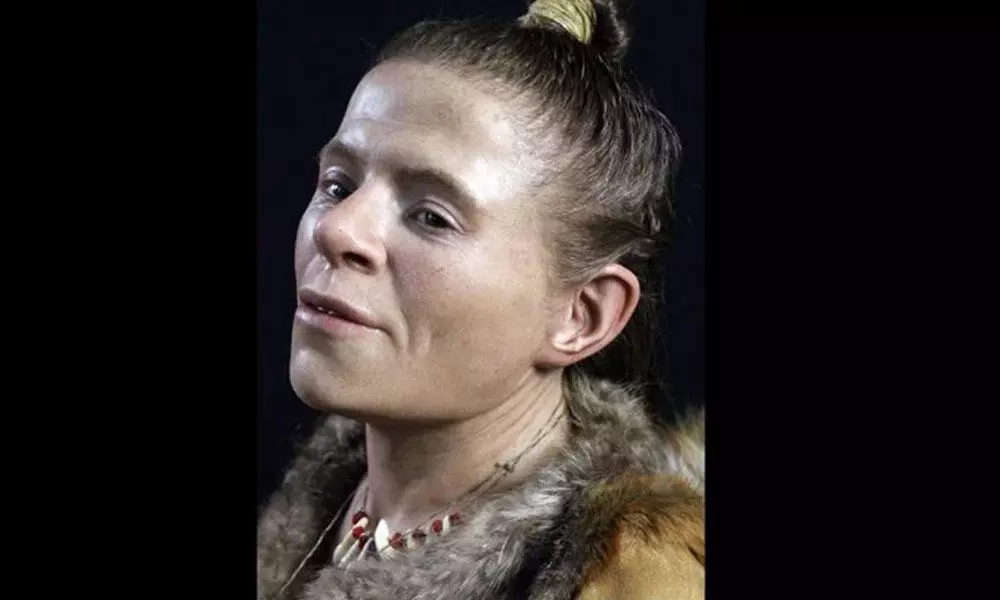Artist Reconstructed Stone Age Woman In Sweden

Model of a Neolithic woman. (Oscar Nilsson)
- A Stone Age mother leans on her walking stick and looks ahead as a passionate little son bursts into a run.
- Workers discovered her skeleton remains buried close to the remains of a child, most likely a 7-year-old boy, while constructing a road in the hamlet of Lagmansören in 1923.
In a beautiful life-size reconstruction currently on exhibit in Sweden, a Stone Age mother who lived almost 4,000 years ago leans on her walking stick and looks ahead as a passionate little son bursts into a run.Although her resemblance is new it premiered last month in a Vasternorrlands Museum display about ancient people where experts have known about her existence for nearly a century.
Workers discovered her skeleton remains buried close to the remains of a child, most likely a 7-year-old boy, while constructing a road in the hamlet of Lagmansören in 1923.
Oscar Nilsson, the Sweden-based forensic artist who spent 350 hours for building the lifelike model replica said that people can tend to imagine that this is a mother and son with their eyes and perhaps at all times. It was also possible that they're siblings: a sister and a brother. They could be blood relations or merely tribe friends. We don't know because the DNA wasn't properly conserved enough to establish a link.
However, while Nilsson shaped the woman's face and moulded her posture, he claimed that she was close to her kid, who was sprinting ahead of her. The Neolithic lady and child were buried in a cist grave, which is a coffin-shaped burial made of long, flat stones. The woman died in her late twenties or early thirties, at 4 feet 11 inches tall. Even for the Neolithic time, she wasn't particularly tall.
The woman's remains showed no evidence of hunger, injuries, or disease, however Nilsson speculated that she may have died of an ailment that didn't leave an imprint on her body.
He said that the study of the isotopes in her teeth revealed that she ate land-based food, which was strange considering that her tomb was discovered beside a fish-filled river near the shore.
When Nilsson was given the task of reconstructing the woman two years ago, he scanned her skull and used a plastic 3D printer to create a replica.
As with other reconstructions he has done, such as those of an ancient Wari queen from what is now Peru and a Stone Age man whose head was discovered on a spike, Nilsson had to account for the ancient person's sex, age, weight, and ethnicity all of which can affect the thickness of facial tissue and overall appearance. He couldn't tell the woman's genetic heritage, hair colour, or eye colour since her DNA was too damaged.
He explained that regarding her appearance, he made an educated estimate. Nilsson gave the woman dark hair and eyes, as well as light skin that resembled that of the farmers. Despite this, the woman wasn't necessary a full-time farmer; he believes she did a combination of hunting and gathering as well as agricultural operations.
He added that it was impossible to establish whether she was living a nomadic life or if she was living the life of the early farmers. However, they have gone with the safest interpretation, which is that she was both, because there was a long period of transition when they left the previous way of life.
The woman from Lagmansören is clad entirely in fur and leather in the recreation. Helena Gjaerum, an independent archaeologist located in Sweden, utilizes Stone Age tanning practises in her work.
Gjaerum researched the Neolithic Lagmansören climate, geography, vegetation, and animal life before clothing the model. She made the woman's garments out of deer, moose, and elk, and the shoes out of reindeer, beaver, and fox, based on what she learned, a report published by Sciencealert. Following that, the skins were massaged, boiled, stretched, and smoked, and ultimately the outfit was designed.
Next Story
















